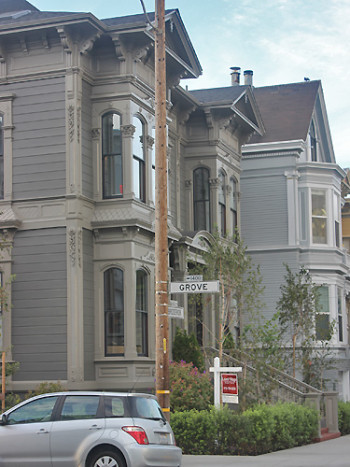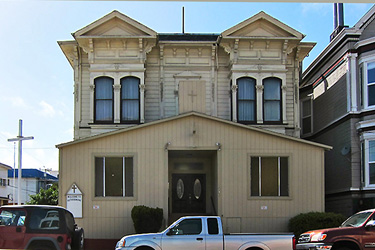

601 Broderick Street at Grove in the heart of NoPa went on the market on October 10th for $5,875,000, 2 1/2 years after the foreclosed black church and fixer-upper was snatched up for 40% above asking at $1,401,000. The open house offered valet service and sushi. Curbed sf’s Tracy Elsen calls it “our absolute favorite flip of the year.”
We featured 601 Broderick in our post Last Days at Gethsemene, noting its place in the origins of historical preservation within the San Francisco Planning Department. Hoodline.com followed up noting provocative neighborhood commentary. For sale on the left: the Gethsemane Missionary Baptist Church in 2012; on right: 601 Broderick restored and re-purposed as a single family home for 2014.


Gentrification has rolled down Divisadero Street through NoPa and Western Addition at such hair-raising velocity that Google bus and $4 toast complaints have become tired cliches of an unstoppable prosperity boom, more so as we befriend new neighbors and clients who enjoy both.  601 Broderick is one of several properties we featured in 2012 that have since flipped to new uses as the vulnerabilities of an established community of fixer uppers are seized by a new community as promising commercial opportunities. The City’s investment has been instrumental in the community transformation through the good intentions of the Great Streets program (Divisadero street beautification), Pavement to Park (parklets), and San Francisco Center for Economic Development (connecting businesses with parcels). The results have created an economic miracle of commercially active street life on the incredibly noisy, congested and traffic challenged Divisadero Corridor, flipping affordability for walk scores.
601 Broderick is one of several properties we featured in 2012 that have since flipped to new uses as the vulnerabilities of an established community of fixer uppers are seized by a new community as promising commercial opportunities. The City’s investment has been instrumental in the community transformation through the good intentions of the Great Streets program (Divisadero street beautification), Pavement to Park (parklets), and San Francisco Center for Economic Development (connecting businesses with parcels). The results have created an economic miracle of commercially active street life on the incredibly noisy, congested and traffic challenged Divisadero Corridor, flipping affordability for walk scores.
 Well worth a good thumbing through, the Storied Houses of Alamo Square by longtime Alamo Square resident Joseph Pecora gives us the early history of 601 Broderick. Mr. Abraham Bloch, arrives in San Francisco in 1853 as a gold rush arriviste in clothing retail. In 1886 he invests in his dream home and begins a second career as developer of other properties along the newly constructed Hayes Street cable car line (and future Google bus line) through Western Addition. The home at 601 quickly passes from luxury home to rental income. Pecora notes:
Well worth a good thumbing through, the Storied Houses of Alamo Square by longtime Alamo Square resident Joseph Pecora gives us the early history of 601 Broderick. Mr. Abraham Bloch, arrives in San Francisco in 1853 as a gold rush arriviste in clothing retail. In 1886 he invests in his dream home and begins a second career as developer of other properties along the newly constructed Hayes Street cable car line (and future Google bus line) through Western Addition. The home at 601 quickly passes from luxury home to rental income. Pecora notes:
“By 1910, 601 Broderick’s principal tenant, an enterprising woman named Annie Tuohey, had turned the large dwelling and its rear addition into what by today’s standards would be termed an overpopulated boarding house. According to the federal census of that year, it’s 21 occupants include Mrs. Tuohey, her four children, three in-laws, two boarders, five lodgers and two other households of three persons each.”
From another viewpoint it could be said:
In a pre-Airbnb violation of modern zoning and rental contracts, master-tenant Annie Tuohey takes direct action against the housing crisis and affordability in her fight to survive during the extreme boom and bust cycles afflicting her neighborhood. A working, single mother, she single-handedly creates a workforce incubator and model for co-housing a 100-years hence.
Peeping through windows, the renovated home appears to have great potential for communal living or Airbnb rentals with generous open spaces for living and dining. Speaking from experience, communal living can be fun: on the left hanging with roomies in 1943; on the right, local co-housing 2013; on the very bottom, Scott Street Commune in 1972.


After 50 years of use as affordable rentals the boarding house was purchased in 1953 by the Zion Hill Missionary Baptist Church. In a pact with the devil, the congregation appears to have joined other local African American congregations in receiving assistance from the San Francisco Redevelopment Agency in exchange for their support of Urban Renewal which with bulldozers, wrecking balls and house moving trucks proceeded to rip out the heart of the Fillmore, Geary and Sutter Street neighborhood street scene and social life, demolishing the so-called blight of bars, hang-out corners and jazz clubs of the black community.
After another 60 years as a church with second floor residence, the recent restoration takes us back a century to a 19th Century luxury home. Admired by both neighborhood and City Planning, the meticulous exterior historic restoration reflects the genuine care of the developer David Papale in creating a more attractive neighborhood. It’s lovely work. Stunned by the beautiful transformation, the community suffers a temporary lapse of localized amnesia and conveniently forgets the loss of affordable housing.
Below, the wildly exuberant Victorian entry portico intact in 1959 and more sedate 2014 restoration shortly before initial offering.


Thanks to Elise Hu for her great photo of good living in co-housing in 2014 and David Weisman and Bill Weber for Communal Living “Is this Oz?” from “The Cockettes.” And to Adam Roberts and the Mill for $4 toast, and the Matthew Evans Resource Room at San Francisco State University. Also the provocative, exhaustive, righteous Redevelopment: a Marxist Analysis 1974. And to Kaliflower: the Intercommunal [Free] Newspaper for the Scott Street Commune at 1209 Scott Street photographed shortly before demolition of their affordable housing by the San Francisco Urban Redevelopment Agency.

